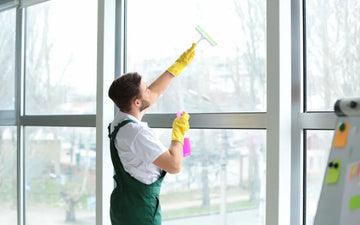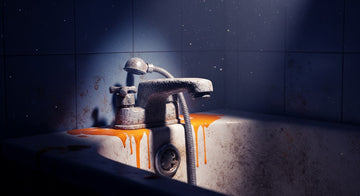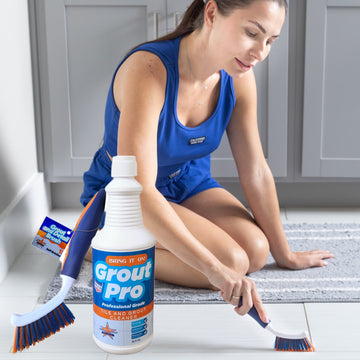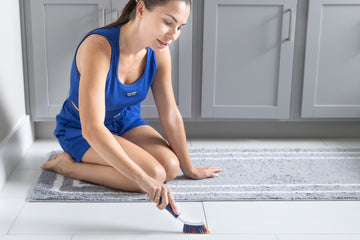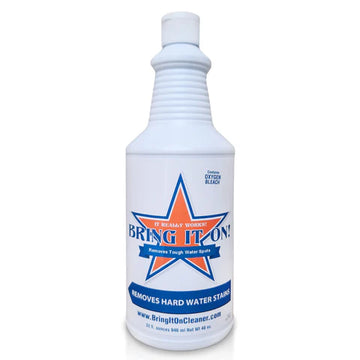Clean Windows with Vinegar
Elevate the shine of your windows without the need for harsh chemicals! Discover an eco-friendly, cost-effective solution found right in your kitchen pantry. Clear views and spotless glasses are just a few spritzes away once you realize the wonders of vinegar. Read on to discover how vinegar - nature's secret weapon - is the simple and natural way to all your window cleaning needs. Let's bring streak-free radiance back into your homes, one window at a time!
Yes, you can clean windows with vinegar. Vinegar's natural acidity helps cut through grime and deters streaking, making it an effective and safe option for cleaning windows. A simple DIY recipe is to mix one part vinegar to 10 parts warm water in a spray bottle, but avoid using on fiberglass, vinyl, or wood frames as it can cause damage. Microfiber cloths are recommended for wiping the windows after applying the solution and drying them with another clean, dry microfiber cloth. When you run into hard water you may need something a bit stronger, here is the product I recommend. Bring It On Cleaner
Benefits of Cleaning Windows with Vinegar

Cleaning windows with vinegar offers numerous benefits that make it a preferred choice for those seeking a simple and natural way to achieve sparkling results. Let's explore some of these benefits in greater detail.
Effectiveness: Vinegar, with its natural acidity, cuts through grime, dirt, and streaks on windows effectively. It tackles stubborn spots and residue left by commercial cleaners, leaving your windows gleaming and clear.
Affordability: Using vinegar as a cleaning solution is highly cost-effective compared to purchasing specialized window cleaning products. A simple DIY recipe consisting of one part vinegar to ten parts warm water can provide ample cleaning power without breaking the bank.
Environmentally Friendly: One of the most significant advantages of using vinegar to clean windows is its minimal impact on the environment. Unlike many traditional window cleaners that contain harsh chemicals, vinegar is a natural and eco-friendly option. By opting for vinegar, you contribute to reducing pollution and waste.
Versatility: Vinegar is not limited to just window cleaning; it can be used as a multi-purpose cleaner throughout your home. From kitchen countertops to bathroom tiles, vinegar is a versatile product that can handle various cleaning tasks effectively.
Now that we've discussed the benefits of using vinegar for window cleaning, let's delve into its safety and environmental advantages.
In a survey conducted by Nielsen, it was revealed that 60% of global consumers prefer cleaning products that are environmentally friendly. Vinegar as an all-natural window cleaner fits into this category. Market analysts forecast that the natural cleaning product market, including DIY solutions such as vinegar, is projected to grow annually by more than 11% through 2025. A study published in the Journal of Environmental Health suggested that homemade cleaners, such as white vinegar and water mixtures, can be just as effective at removing bacteria from surfaces as commercial household disinfectants.
Cleaning windows with vinegar is an effective, affordable, environmentally friendly, and versatile solution that can offer sparkling results and tackle stubborn spots and residue left by commercial cleaners. By choosing vinegar as a natural and eco-friendly option for window cleaning, you contribute to reducing pollution and waste while also being able to use it as a multi-purpose cleaner throughout your home.
Safety and Environmental Advantages

Traditional window cleaners often contain chemicals that can pose health risks if inhaled or come into contact with the skin. In contrast, vinegar provides a safe alternative for both you and the environment.
Health Consciousness: Vinegar does not release harmful fumes or irritate the respiratory system when used for window cleaning. This makes it an excellent choice for individuals who are sensitive to strong chemical odors or have respiratory conditions such as asthma or allergies.
Protective Surfaces: Vinegar's mild acidity makes it a suitable option for cleaning windows without damaging surrounding surfaces. It is gentle enough to use on glass, window frames, and other materials, reducing the risk of discoloration or deterioration.
Reduced Chemical Exposure: By using vinegar instead of commercial window cleaners, you minimize your exposure to potentially hazardous chemicals. This not only protects your health but also reduces the amount of harmful substances released into the environment.
Renewable Resource: Vinegar is derived from natural sources such as fermented apples or grains, making it a renewable resource. Choosing vinegar as a window cleaning solution aligns with sustainable practices that aim to reduce reliance on non-renewable resources.
Cleaning windows with vinegar provides a plethora of benefits, from its effectiveness in achieving streak-free results to being safe for both human health and the environment. Now that we understand the advantages, let's move on to exploring the ideal vinegar solution for window cleaning.
Ideal Vinegar Solution for Window Cleaning

When it comes to cleaning windows with vinegar, creating the ideal solution is key to achieving sparkling results. Vinegar's natural acidity and antimicrobial properties make it an effective and environmentally-friendly option for removing grime and streaks. But what makes up the ideal vinegar solution for window cleaning?
Let's dive into the essential ingredients and proportions that will help you create a powerful vinegar solution for your window cleaning needs.
Essential Ingredients and Proportions

To create the perfect vinegar solution, you'll need two primary ingredients: white vinegar and water. White vinegar, also known as distilled vinegar, is the preferred choice for window cleaning due to its clear color and mild scent. It is typically used in combination with water, which helps dilute the vinegar's acidity while still maintaining its effectiveness.
The exact proportions of vinegar to water can vary depending on personal preference and the level of dirtiness on your windows. However, a common recommendation is to mix equal parts of white vinegar and warm water. This 1:1 ratio provides a balanced blend that effectively cuts through grime without leaving behind streaks.
For example, if you're using one cup of white vinegar, you would combine it with one cup of warm water. This combination ensures that you have enough acidity from the vinegar to tackle dirt and stains while maintaining a safe balance with the water.
It's important to note that some prefer slightly stronger or weaker solutions based on their unique circumstances. If your windows are excessively dirty or haven't been cleaned in a long time, you may opt for a slightly stronger mixture with a higher concentration of vinegar.
However, it's crucial to avoid using undiluted vinegar, as its high acidity can damage certain types of window frames such as fiberglass, vinyl, or wood. Always exercise caution and test the solution on a small area before proceeding with full-scale window cleaning.
Armed with the knowledge of the ideal vinegar solution ingredients and proportions, we can now move on to the next section: a step-by-step guide to clean windows with vinegar.
Step-by-Step Guide to Clean Windows with Vinegar

Cleaning windows with vinegar is a simple and effective way to achieve sparkling, streak-free results. Here is a step-by-step guide to help you through the process:
Start by gathering all the necessary supplies. You will need white vinegar, warm water, a spray bottle, microfiber cloths or lint-free paper towels, and a squeegee.
Mix equal parts of vinegar and warm water in a spray bottle. This solution will be your natural window cleaning agent.
Begin by preparing the windows for cleaning. Remove any dirt or dust from both the interior and exterior surfaces using a soft-bristled counter brush or a vacuum cleaner attachment.
Spray the vinegar solution onto the window glass, covering it evenly. Take care not to saturate the windows excessively, as it can lead to dripping and streaking.
Now, grab your microfiber cloth or lint-free paper towel and starting from the top of the window, wipe down in vertical motions. Make sure to apply consistent pressure and cover the entire surface.
Once you have wiped down one section of the window, move quickly to squeegeeing that section before moving on to the next area. This prevents the vinegar solution from drying on the glass and causing streaks.
Hold the squeegee at an angle against the glass and draw it firmly down in a straight stroke from top to bottom. Wipe off any excess liquid on the rubber edge after each stroke using a clean cloth.
Repeat this process until all sections of the window are cleaned and squeegeed.
For extra stubborn grime or heavily soiled windows, you can directly spray additional vinegar solution onto those areas before wiping them clean.
After cleaning and squeegeeing the windows, use a clean, dry microfiber cloth or lint-free paper towel to gently buff and dry the glass. This step helps remove any remaining streaks and ensures a flawless finish.
Take a step back and admire your sparkling, vinegar-cleaned windows!
Ensuring a Streak-free Shine

While cleaning your windows with vinegar can be highly effective, it's essential to follow certain techniques to ensure a streak-free shine. Here are some tips to help you achieve flawless results:
Choose the right weather conditions: It's best to clean windows on a cloudy day or when the sun is not directly shining on them. Direct sunlight can cause the vinegar solution to evaporate quickly, leaving behind streaks.
Use the right tools: Opt for high-quality microfiber cloths or lint-free paper towels instead of regular rags or newspapers. These materials are excellent at absorbing moisture and preventing lint or residue from being left behind.
Pay attention to drying technique: Ensure that you thoroughly buff and dry each section of the window after cleaning with the squeegee. This step helps eliminate any remaining moisture and prevents streaks from forming.
Avoid oversaturation: Be cautious not to oversaturate the windows with the vinegar solution. Too much liquid can lead to dripping and streaking during the cleaning process.
Be patient: Take your time while wiping and squeegeeing each section of the window. Rushing through the process may result in streaks or missed spots.
By following these tips, you can maximize the effectiveness of vinegar as a natural window cleaner while achieving streak-free, crystal-clear windows.
Extra Tips for Effective Vinegar Window Cleaning

While vinegar is a fantastic natural cleaner for windows, there are a few extra tips and tricks you can employ to maximize its effectiveness. These techniques will help you achieve sparkling, streak-free windows that will impress even the toughest critics.
Firstly, it's important to choose the right vinegar for the job. While white distilled vinegar is the most commonly used type, apple cider vinegar can also be effective. Whichever vinegar you choose, make sure it is clear and free from any added flavors or colors that could potentially leave residue on your windows.
Next, prepare your cleaning solution by mixing one part vinegar to ten parts warm water in a spray bottle. If your windows are particularly dirty or have stubborn grime, you can increase the concentration of vinegar slightly. Be cautious not to use undiluted vinegar as it can be too strong and damage certain types of window frames.
Before you begin spraying the solution directly onto your windows, take a moment to remove any loose dirt or dust using a soft-bristled brush. This will prevent scratching and ensure a smoother cleaning process. Starting from the top corner of the window, spray the vinegar solution evenly across the surface.
To avoid streaks during cleaning, it's helpful to use a microfiber cloth instead of paper towels or regular cloths. Microfiber is designed to pick up dirt and debris without leaving lint behind. Begin wiping the window with long, horizontal strokes, working your way down from top to bottom. Regularly rinse your cloth in clean water to avoid redepositing dirt onto the window surface.
Think of cleaning your windows like painting a picture - smooth, even strokes yield better results than haphazard dabbing.
For stubborn spots or streaks that refuse to budge, you can apply additional vinegar solution directly to them and let it sit for a few minutes before wiping again. Patience is key here, as allowing the vinegar to work its magic will make the cleaning process easier.
Another useful tip is to clean windows on a cloudy day or when the sun is not directly shining on them. This helps prevent the cleaning solution from drying too quickly, reducing the likelihood of streaks and water spots. If you do find a few streaks after cleaning, simply reapply the vinegar solution and wipe again until you achieve a crystal-clear finish.
By following these extra tips for effective vinegar window cleaning, you'll be able to achieve professional-looking results without relying on harsh chemicals or expensive cleaners. Embrace the natural power of vinegar and enjoy beautifully clean and shiny windows that enhance the overall appearance of your home or office.

